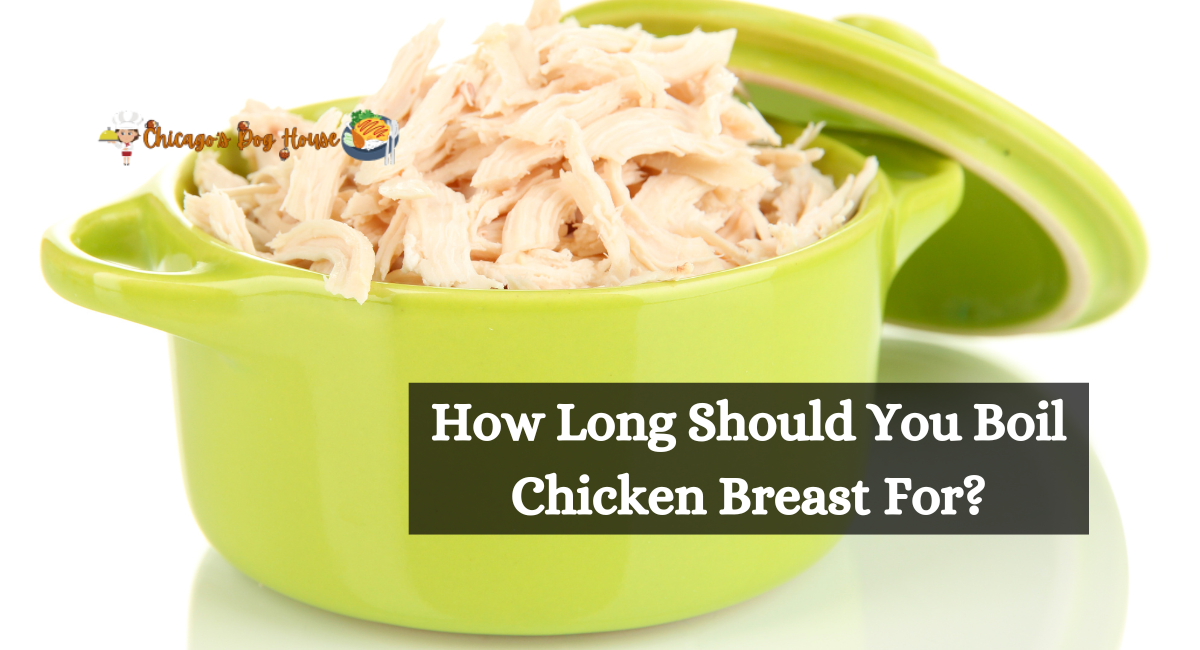You can prepare chicken in numerous ways, serving as the foundation for various delicious dishes, including chicken enchiladas, poached chicken salad, chicken paninis, and chicken noodle soup. However, you should ensure that your chicken is tender and succulent; nothing is worse than dry chicken! Knowing the best method and length of time to boil chicken will prevent it from becoming desiccated. So, how long should you boil chicken breast for?
Poached chicken and boiled chicken are interchangeable expressions. The best way to prepare chicken breasts, which can rapidly dry when roasted or grilled if we turn our heads for even one minute, is to boil them.
Skin-on, bone-in breasts are optimal for burning to create a flavorful broth. Choose boneless, skinless chicken breast halves to reduce cooking time. For the shortest cooking time, use chicken breast that has cut up. After boiling chicken breast, you can use it in various preparations.
How Can You Boil Chicken Breast?
Shredded chicken breasts are the ultimate source of protein for salads, soups, and even buffalo chicken sauce! This chicken is straightforward to prepare and turns out succulent and tender.
Time
- Yields: 6 servings.
- Preparation Time: 5 minutes.
- Time Total: 20 minutes
Ingredients
- 4 poultry breasts
- 1 teaspoon coarse salt
- 3 crushed large garlic cloves
- 1 teaspoon peppercorns whole
- 3 parsley leaves (optional) water
Instruction
Here are instructions of boiling chicken breast:
1. Pick y Your Liquid.
Indeed, you could boil your poultry in water, but that seems rather dull, no? By cooking chicken in chicken broth, you can instantaneously enhance its flavor.
2. Season It.
Mix enough liquid to cover the chicken breasts in a large skillet with a tight-fitting lid before adding the chicken breasts. It is essential to season your liquid well with salt and pepper. It is identical to boiling a container of pasta. Add onions, carrots, or fresh herbs to the broth. All the flavors will come from the ingredients you place in the pot, so the more, the better.
3. Bring It To A Boil.
Once all of the flavors have been added, bring the water to a simmer. Cover the container and slightly reduce the heat to maintain a rapid simmer. Depending on the quantity of the chicken breasts, simmer them for approximately 10 minutes. After 10 minutes, remove and inspect one piece from the kettle. The temperature inside should be 165 degrees. If additional time is required, verify every 5 minutes. If you overcook them, they will become gelatinous.
4. Shred It Up.
After removing the chicken from the pot, allow it to settle for approximately 10 minutes. It will make them cold enough to shred and prevent them from drying out by retaining some moisture. Use two utensils to shred or slice your chicken.
How Long Does It Take To Boil Chicken Breasts?
The boiling time for boneless chicken breasts is half that of bone-in chicken breasts. Set the timer for 12 minutes and use a meat thermometer to verify the internal temp of the boneless chicken breasts. When the temperature reaches 165°F, the simmering process is complete.
How To Store And Freeze Boiled Chicken?
Use the chicken meat immediately, or refrigerate it for up to five days. Additionally, you can freeze the cooked chicken for up to three months. Before preserving chicken, I suggest shredding or slicing it.
Also, do not discard the cooking liquid! This method yields a chicken broth with a mild flavor that can be used instead of chicken broth in other recipes or as a cooking liquid for rice and other grains. You can also consume it on its own!
Tips And Tricks
Here are the many tips and tricks to boiled chicken breast:
- Flavor Enhancements: You can enhance the flavor of the boiled chicken by adding additional seasonings such as herbs (rosemary, thyme), citrus (lemon, lime), or even a splash of chicken broth for added dimension.
- Poaching vs. Boiling: Aim for a moderate simmer when poaching instead of a vigorous boil. It will prevent the poultry from overcooking and becoming tough. The high heat of a roiling spot can cause the chicken’s proteins to coagulate, resulting in a more robust texture.
- Use A Thermometer: To ensure chicken is safe to consume, cook it to an internal temperature of 165°F (74°C). Utilize a digital meat thermometer to measure the temperature precisely. Without touching the bone, insert the thermometer into the thickest portion of the poultry.
- Size Consistency: If your chicken breasts are of varying sizes, consider lightly pounding them to obtain a more uniform thickness. It will aid in preparing evenly.
- Resting Period: After boiling, allow the poultry to rest for a few minutes. It redistributes the juices throughout the flesh, producing a juicier and more flavorful product.
- Shredding Techniques: If you shred chicken, cool it before using two forks to pull the flesh apart. Alternatively, you can use a handheld mixer with an attachment for a whisk to shred food more quickly.
- Cooking Liquid: The chicken-boiling water can be infused with additional flavors. Add sliced onions, carrots, celery, bay leaves, or other aromatics to the water for a more flavorful broth.
- Reuse Cooking Liquid: Do not discard cooking liquid! It can be used as a base for chicken noodle broth, stews, and sauces, giving your dishes additional chicken flavor.
- Storage: If you are going to wait to use the boiled chicken, you should store it correctly. Leave the chicken to settle to a pleasant temperature before storing it in the freezer or fridge. Use an airtight container or a freezer-safe sack for storage.
- Recipe Variations: Chicken that has been boiled can be used in various dishes, including meal prep, chicken salad, sandwiches, stews, and casseroles. Experiment with multiple seasonings and relishes to develop novel tastes.
- Choose any liquid for boiling: Choose from water, broth, apple cider vinegar, dry white wine, or beer for simmering.
- Add vegetables to the pan while simmering to enhance the flavor—an excellent method to utilize leftover vegetables (celery, carrots, onions) from the refrigerator.
- Adapt the spices to your taste. The combination of peppercorns and parsley is one of many seasoning combinations.
- Before adding the garlic to the skillet, it is smashed. It enables the garlic oils to infuse the liquid and flavor the chicken.
- Instead of bone-in chicken breasts, choose boneless, skinless breasts for faster heating.
Depending on its thickness, the optimal boiling time for chicken breast ranges from 12 to 30 minutes. Essential for safe consumption is reaching an internal temperature of 165°F (74°C). Overcooking can result in a desiccated chicken, so monitoring the chicken’s doneness is essential for a juicy and flavorful dish.
Thank you for reading…..





